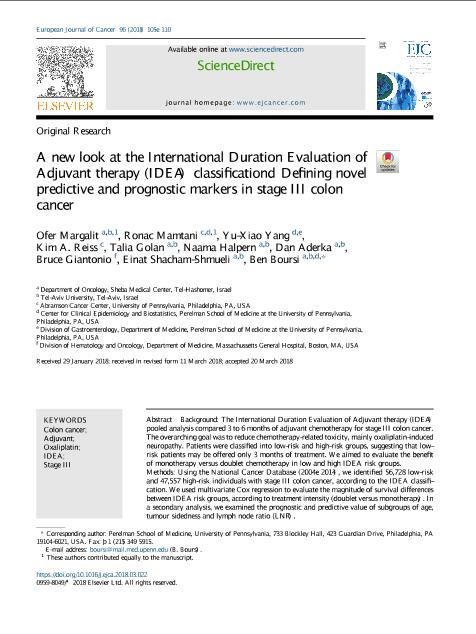
暂无数据~
A new look at the International Duration Evaluation of Adjuvant therapy (IDEA) classification—Defining novel predictive and prognostic markers in stage III colon cancer 
Abstract Background The International Duration Evaluation of Adjuvant therapy (IDEA) pooled analysis compared 3 to 6 months of adjuvant chemotherapy for stage III colon cancer. The overarching goal was to reduce chemotherapy-related toxicity, mainly oxaliplatin-induced neuropathy. Patients were classified into low-risk and high-risk groups, suggesting that low-risk patients may be offered only 3 months of treatment. We aimed to evaluate the benefit of monotherapy versus doublet chemotherapy in low and high IDEA risk groups. Methods Using the National Cancer Database (2004–2014), we identified 56,728 low-risk and 47,557 high-risk individuals with stage III colon cancer, according to the IDEA classification. We used multivariate Cox regression to evaluate the magnitude of survival differences between IDEA risk groups, according to treatment intensity (doublet versus monotherapy). In a secondary analysis, we examined the prognostic and predictive value of subgroups of age, tumour sidedness and lymph node ratio (LNR). Results Low and high IDEA risk groups derived similar benefit from doublet adjuvant chemotherapy as compared with monotherapy, with hazard ratios (HRs) of 0.83 (95% confidence interval [CI] 0.79–0.86) and 0.80 (95% CI 0.78–0.83), respectively. The only subpopulations that did not benefit from doublet chemotherapy were low-risk patients older than 72 years (HR = 0.95, 95% CI 0.90–1.01) and high-risk patients older than 85 years (HR = 0.90, 95% CI 0.77–1.05). LNR and tumour sidedness were shown as additional prognostic, but not predictive, factors within the IDEA risk groups. Conclusions IDEA risk classification per se does not predict for treatment benefit from doublet chemotherapy in stage III colon cancer. However, omission of oxaliplatin can be considered in IDEA low-risk patients older than 72 years.

Once-weekly dulaglutide versus bedtime insulin glargine, both in combination with prandial insulin lispro, in patients with type 2 diabetes (AWARD-4): a randomised, open-label, phase 3, non-inferiority study 
Summary Background For patients with type 2 diabetes who do not achieve target glycaemic control with conventional insulin treatment, advancing to a basal–bolus insulin regimen is often recommended. We aimed to compare the efficacy and safety of long-acting glucagon-like peptide-1 receptor agonist dulaglutide with that of insulin glargine, both combined with prandial insulin lispro, in patients with type 2 diabetes. Methods We did this 52 week, randomised, open-label, phase 3, non-inferiority trial at 105 study sites in 15 countries. Patients (aged ≥18 years) with type 2 diabetes inadequately controlled with conventional insulin treatment were randomly assigned (1:1:1), via a computer-generated randomisation sequence with an interactive voice-response system, to receive once-weekly dulaglutide 1·5 mg, dulaglutide 0·75 mg, or daily bedtime glargine. Randomisation was stratified by country and metformin use. Participants and study investigators were not masked to treatment allocation, but were unaware of dulaglutide dose assignment. The primary outcome was a change in glycated haemoglobin A1c (HbA1c) from baseline to week 26, with a 0·4% non-inferiority margin. Analysis was by intention to treat. This trial is registered with ClinicalTrials.gov, number NCT01191268. Findings Between Dec 9, 2010, and Sept 21, 2012, we randomly assigned 884 patients to receive dulaglutide 1·5 mg (n=295), dulaglutide 0·75 mg (n=293), or glargine (n=296). At 26 weeks, the adjusted mean change in HbA1c was greater in patients receiving dulaglutide 1·5 mg (−1·64% [95% CI −1·78 to −1·50], −17·93 mmol/mol [−19·44 to −16·42]) and dulaglutide 0·75 mg (−1·59% [−1·73 to −1·45], −17·38 mmol/mol [−18·89 to −15·87]) than in those receiving glargine (−1·41% [−1·55 to −1·27], −15·41 mmol/mol [−16·92 to −13·90]). The adjusted mean difference versus glargine was −0·22% (95% CI −0·38 to −0·07, −2·40 mmol/mol [–4·15 to −0·77]; p=0·005) for dulaglutide 1·5 mg and −0·17% (–0·33 to −0·02, −1·86 mmol/mol [–3·61 to −0·22]; p=0·015) for dulaglutide 0·75 mg. Five (<1%) patients died after randomisation because of septicaemia (n=1 in the dulaglutide 1·5 mg group); pneumonia (n=1 in the dulaglutide 0·75 mg group); cardiogenic shock; ventricular fibrillation; and an unknown cause (n=3 in the glargine group). We recorded serious adverse events in 27 (9%) patients in the dulaglutide 1·5 mg group, 44 (15%) patients in the dulaglutide 0·75 mg group, and 54 (18%) patients in the glargine group. The most frequent adverse events, arising more often with dulaglutide than glargine, were nausea, diarrhoea, and vomiting. Interpretation Dulaglutide in combination with lispro resulted in a significantly greater improvement in glycaemic control than did glargine and represents a new treatment option for patients unable to achieve glycaemic targets with conventional insulin treatment. Funding Eli Lilly and Company.


暂无数据~

 V2
V2
